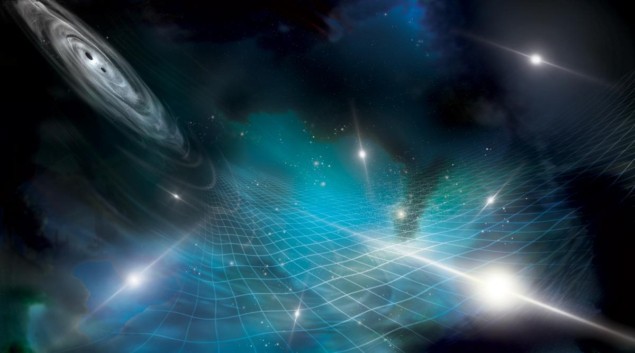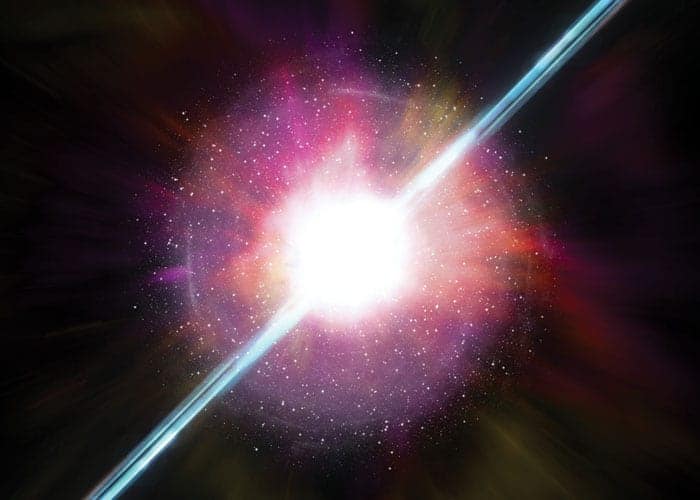
The universe is undulating with a background commotion of gravitational waves that have been emitted by pairs of supermassive black holes. That is according to years’ worth of pulsar observations that have been conducted by several teams of radio astronomers.
Utilizing radio telescopes in the Africa, Asia, Australia, Europe and the US, the teams pioneered the innovative technique of watching for subtle variations in the timing of radio beams from millisecond pulsars.
Millisecond pulsars are one of nature’s most precise clocks – spinning neutron stars that flash radio pulses at us hundreds of times per second with unerring accuracy. As gravitational waves ripple through the space between us and the pulsars in our galaxy, they distort the distance that those pulses have to travel to reach us by about the size of a football pitch.
This results in a pulsar’s pulses arriving at Earth slightly early or slightly late, with the variations in the timing of the pulses amounting to billionths of a second, corresponding to gravitational waves with frequencies in the nanohertz regime.
This is a far lower frequency than the gravitational-wave events detected by LIGO and Virgo, which ranges from 5 to 20 000 Hz. The corresponding wavelength of these background gravitational waves is huge, with the waves stretching between two and 10 light years from peak to peak.
Multiple detections
In the case of the European Pulsar Timing Array (EPTA), it incorporates five of the major radio observatories in France, Germany, Italy, the Netherlands and the UK, and their new results encompass over two decades’ worth of observations. Teams in Australia, China, South Africa and the US have also simultaneously published their pulsar timing data.
“We’re all basically seeing the same thing,” Michael Keith of the University of Manchester and EPTA told Physics World. “That’s certainly encouraging.”
What we’re looking at is a background of noise, with gravitational waves from all over constantly washing over the Earth
Michael Keith
And what everyone is seeing are myriad gravitational waves all overlapping with one another, having been emitted by distant extragalactic sources. Think of waves landing on a beach, one after another and on top of each other.
Keith stresses that these findings are different to the distinct events seen by LIGO, which come from merging neutron stars or stellar-mass black holes.
“What we’re looking at is a background of noise, with gravitational waves from all over constantly washing over the Earth.”
The puzzle of older data
However, the finding comes with a note of caution. Previously the International Pulsar Timing Array (IPTA), which is an umbrella organization for all the different groups in the world working on these detections, had set out a criteria for confirming a detection.
“The slightly awkward thing is that I believe nobody has reached the threshold that IPTA set out,” says Keith. “But we do have quite a lot of confidence in the evidence.”
It’s opening a new window and a new way of looking at the universe
Michael Keith
Assuming the gravitational-wave background detection is real, then the gravitational waves are being emitted by binary supermassive black holes – the type we expect to find at the centres of galaxies. We get two supermassive black holes when there has been a galaxy merger, and just like their parent galaxies have, eventually the supermassive black holes will also merge.
When this happens, they’ll emit a stronger set of gravitational waves at a higher frequency that will be detectable by the space-based Laser Interferometer Space Antenna (LISA), which is a proposal for a mission to launch in the 2030s.

Hunting gravitational waves using pulsars
The EPTA team, who worked in conjunction with Indian and Japanese scientists, also found something puzzling. Their telescopes have been observing and timing pulsars since the 1990s, but the gravitational-wave signal was strongest in the most recent 10-year dataset. When the entire data was added, the signal faded.
“Adding more data shouldn’t make things worse,” says Keith. “This is something that concerns us a little bit.”
One possible explanation is that the more recent data was collected using more sophisticated observing techniques and technology, and that the earlier data by comparison was lower quality with more noise. However, it could also mean that the signal really was weaker back then.
“It’s potentially very exciting because it could turn out that what we’re seeing is the gravitational-wave signal changing over time,” says Keith.
A window on an exotic universe
EPTA based their data on the study of 25 of the brightest and most stable millisecond pulsars in the galaxy. The US team at the NANOGrav Physics Frontiers Center had a larger sample of 67 pulsars observed across 15 years, so unfortunately they don’t have an older dataset to compare with EPTA’s.
Either way, the amount of background gravitational waves suggests a huge population of binary supermassive black holes in the universe, with hundreds of thousands of pairs, if not millions. This is powerful evidence for models of the hierarchical formation of galaxies, whereby galaxies grow by merging with other galaxies.
The next step is to try and sift through the background and distinguish specific gravitational waves and trace them back to their sources, where the data can then be combined with observations in the electromagnetic regime of light. There’s also the potential for new and unexpected discoveries to be made in this new frontier.
“I do think it’s going to welcome in an exotic world over the next few years,” says Keith. “It’s opening a new window and a new way of looking at the universe.”
The results from EPTA are published in Astronomy and Astrophysics. The findings from NANOGrav are published in The Astrophysical Journal Letters. Data from the Chinese Pulsar Timing Array are published in Research in Astronomy and Astrophysics. The Australian Parkes Pulsar Timing Array has published its findings in The Astrophysical Journal Letters and Publications of the Astronomical Society of Australia.
- SEO Powered Content & PR Distribution. Get Amplified Today.
- PlatoData.Network Vertical Generative Ai. Empower Yourself. Access Here.
- PlatoAiStream. Web3 Intelligence. Knowledge Amplified. Access Here.
- PlatoESG. Automotive / EVs, Carbon, CleanTech, Energy, Environment, Solar, Waste Management. Access Here.
- BlockOffsets. Modernizing Environmental Offset Ownership. Access Here.
- Source: https://physicsworld.com/a/pulsar-timing-irregularities-reveals-hidden-gravitational-wave-background/



